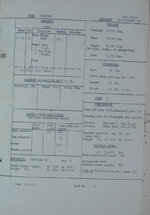don4331
Senior Airman
E EwenS : Do you have any additional information on the F director? (I checked most of the Tech pages on the site here, and didn't find anything but might have missed when distracted by other interesting things of note...)And there was also the F director or Type F sight that was included in the equipment of aircraft like the Barracuda. This was developed by the RAF from 1937. The pilot pointed the aircraft at the target ship, fed in range and speed data etc, and the sight / director set the deflection needed on the torpedo. This superseded the crude arrangement of a sighting bar in front of the cockpit of aircraft like the Swordfish and Albacore, with the pilot doing all the maths involved.
The old system:
Flying my airplane, to arrive at a point 400m* abeam (assuming 40kn torpedo) and 10x the speed of ship in front (e.g. 300m for the 30kn Bismarck), basically keeps me out of LAA range until last possible moment (3/4/5 triangle, says I am 500m away at torpedo drop - decently long range for iron sights at Swordfish doing 100mph and in theory only 1/4 of the LAA can be brought to bear as the rest needs to watch the other 3 quarters). MAA with director control is problem, but hopefully I am between shots of the semi-auto cannons (and again same 1/4 limit).
What you are describing:
Flying directly at the ship - 0* deflection scare the $#!+ out of me as a pilot: 1/2 the LAA and MAA would be targeting me and while there is a slight convergence issue as all the guns aren't exactly midships, I'm not getting warm fuzzies that I'm not a big target.
Even as an engineer, getting the gyros on the plane to provide accurate enough data on speed and range to program the torpedo's gyro for the required deflection seems at technological limits for '37. And then the torpedo has to execute both the stabilization for depth and the turn to the require angle in the 400m (maybe a little more with the curve). It does help that it is a 1D problem of 100+ meters; don't need to worry about it moving up/down, and torpedo is running through anything ahead of it.
So, any data you have is appreciated.
*400m being more/less the distance for torpedo to have achieved stable running depth/armed, which allows minimum time for evasive maneuvers of the vessel.

